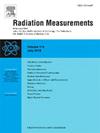Influence of field positioning errors on beam characteristics and dose parameters in small field radiation therapy
IF 2.2
3区 物理与天体物理
Q2 NUCLEAR SCIENCE & TECHNOLOGY
引用次数: 0
Abstract
In radiation therapy, accidental displacement of the treatment field from the central axis can occur, leading to deviations from the intended dose distribution, especially for small treatment fields due to associated challenges. This study investigates the influence of small field displacements on radiation beam characteristics and dosimetric parameters using a validated Monte Carlo simulation of an Elekta Synergy linear accelerator with an MLCi2 multi-leaf collimator. For the investigated field sizes, simulated and measured dose distributions showed good agreement based on statistical tests and quality factors. Depth dose and lateral dose profiles were compared for various displacements along the X-axis relative to the central axis. A significant decrease exceeding 27% in the absorbed dose was observed due to field displacement, with the deviation being more pronounced in the region of the maximum dose and decreasing with depth. Despite displacement, the relative dose distributions exhibited a consistent pattern. An overall reduction in the number of particles reaching the phantom surface was observed, following a second-order polynomial function with displacement, while maintaining a consistent dose deposition manner. The energy spectrum showed a global decrease across all energies, but with minimal changes () in the average and maximum energies. Larger discrepancies were observed for the minimum energy, attributed to statistical fluctuations inherent to Monte Carlo simulations.
In conclusion, small field displacements do not significantly impact the overall dose deposition pattern. The observed reductions in energy spectrum and absorbed dose can be compensated based on pre-quantified relationships with the estimated displacement, enabling accurate dose delivery even in the presence of small field misalignment.
场定位误差对小场放射治疗光束特性和剂量参数的影响
在放射治疗中,可能发生治疗场偏离中心轴的意外位移,导致偏离预期剂量分布,特别是对于由于相关挑战而产生的小治疗场。本研究通过对Elekta Synergy线性加速器MLCi2多叶准直器的蒙特卡罗模拟,研究了小场位移对辐射束特性和剂量学参数的影响。基于统计检验和质量因素,模拟剂量分布与实测剂量分布具有良好的一致性。比较了相对于中心轴沿x轴不同位移的深度剂量和侧位剂量分布。由于场位移的影响,吸收剂量有超过27%的显著下降,这种偏差在最大剂量区域更为明显,随深度的增加而减小。尽管有位移,但相对剂量分布呈现一致的模式。在保持一致的剂量沉积方式的同时,观察到到达幻影表面的粒子数量总体减少,遵循与位移的二阶多项式函数。能谱显示出所有能量的整体下降,但平均能量和最大能量的变化最小(<1.1%)。由于蒙特卡罗模拟固有的统计波动,在最小能量上观察到较大的差异。综上所述,小场位移对整体剂量沉积模式没有显著影响。观测到的能谱和吸收剂量的减少可以根据预量化的与估计位移的关系进行补偿,即使在存在小的场偏差的情况下也能实现准确的剂量传递。
本文章由计算机程序翻译,如有差异,请以英文原文为准。
求助全文
约1分钟内获得全文
求助全文
来源期刊

Radiation Measurements
工程技术-核科学技术
CiteScore
4.10
自引率
20.00%
发文量
116
审稿时长
48 days
期刊介绍:
The journal seeks to publish papers that present advances in the following areas: spontaneous and stimulated luminescence (including scintillating materials, thermoluminescence, and optically stimulated luminescence); electron spin resonance of natural and synthetic materials; the physics, design and performance of radiation measurements (including computational modelling such as electronic transport simulations); the novel basic aspects of radiation measurement in medical physics. Studies of energy-transfer phenomena, track physics and microdosimetry are also of interest to the journal.
Applications relevant to the journal, particularly where they present novel detection techniques, novel analytical approaches or novel materials, include: personal dosimetry (including dosimetric quantities, active/electronic and passive monitoring techniques for photon, neutron and charged-particle exposures); environmental dosimetry (including methodological advances and predictive models related to radon, but generally excluding local survey results of radon where the main aim is to establish the radiation risk to populations); cosmic and high-energy radiation measurements (including dosimetry, space radiation effects, and single event upsets); dosimetry-based archaeological and Quaternary dating; dosimetry-based approaches to thermochronometry; accident and retrospective dosimetry (including activation detectors), and dosimetry and measurements related to medical applications.
 求助内容:
求助内容: 应助结果提醒方式:
应助结果提醒方式:


